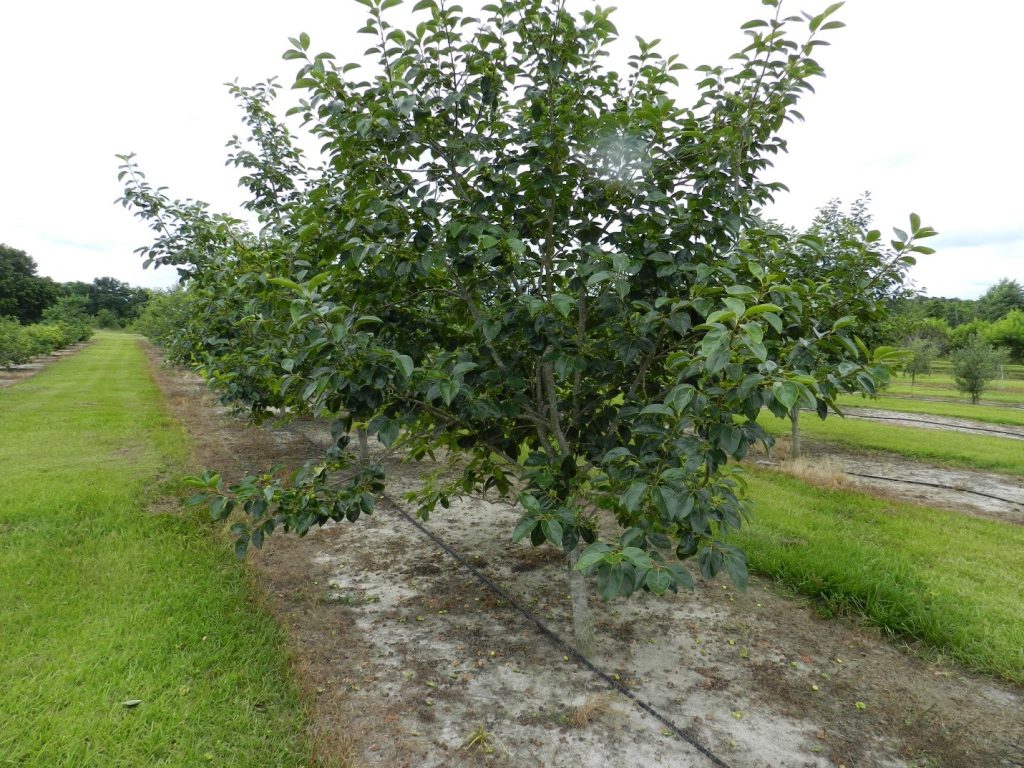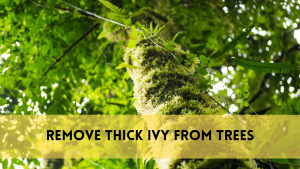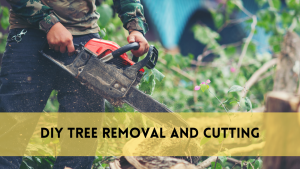Explore the vibrant world of persimmon trees in Florida with this comprehensive guide from Kingwood Arborist. In this post, we will go over the subtleties of persimmon tree cultivation, care, and maintenance, giving you useful insights and expert advice on how to properly nurture these trees. Whether you’re an experienced gardener or a beginner, this book will teach you how to grow healthy persimmon trees in Florida’s unique climate. Join us as we explore the beauty and wealth of persimmon trees, expanding your knowledge of these popular fruit-bearing plants.
Persimmon Trees in Florida
Persimmon trees, which belong to the Diospyros genus, are deciduous fruit-bearing trees known for their tasty and nutritious fruits. These trees normally grow to intermediate heights and have dark green foliage, with some types showing brilliant fall colors. People commonly use persimmon fruit for its sweet flavour in various culinary applications such as jams, jellies, baked dishes, and desserts.
Native varieties in Florida
Florida’s diverse climate and terrain provide an ideal habitat for a various native persimmon tree species. The American persimmon (Diospyros virginiana) and the wild persimmon (Diospyros texana) are particularly notable.
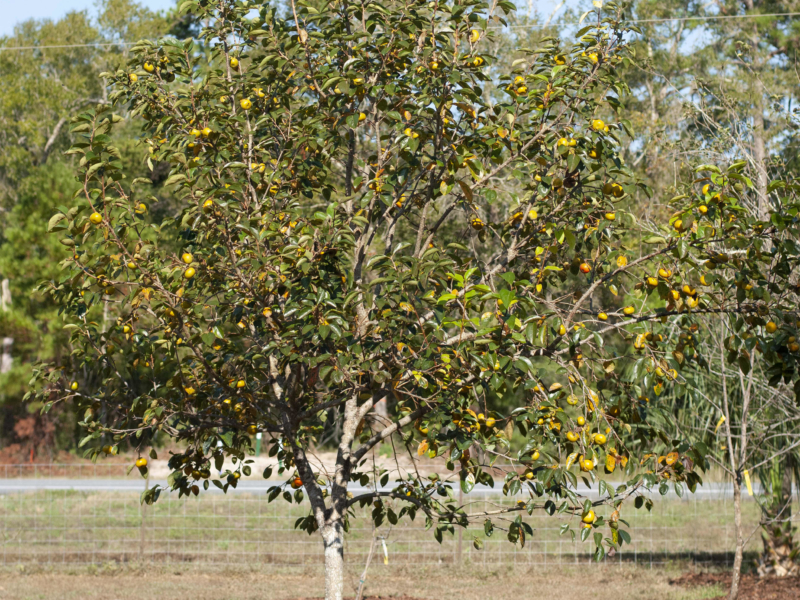
The American persimmon, commonly known as the common persimmon, is a deciduous tree that can grow to heights of 25–60 feet. It produces small, spherical fruit with a sweet, rich flavour when completely ripe. The wild persimmon, on the other hand, is a tiny tree that can grow up to 20–40 feet tall. Its fruit tastes similar to the American persimmon; it may differ somewhat in size and color.
Both these native persimmon species perform important roles in Florida’s ecosystems, supplying food and habitat for wildlife while also adding to the state’s biodiversity.
How to plant persimmon trees in Florida
Choose a suitable location for your persimmon tree.
Tools required: a shovel, rake, compost or aged manure, watering can or hose, and organic mulch.
Prepare the soil: Dig a hole twice the width and depth of the tree’s root ball. Break up any clumps and clear the soil of pebbles, weeds, and rubbish.
Amend the soil: To promote fertility and drainage, add organic materials to the soil, such as compost or old manure.
Plant a Tree: Place the persimmon tree in the centre of the hole, with the top of the root ball level with the soil surface.
Fill the hole with improved soil, gently tamping it down to remove any air pockets.
Water Thoroughly: To settle the dirt around the roots, deeply water the newly planted tree.
Mulch: To conserve moisture and prevent weeds, spread a layer of organic mulch around the tree’s base.
How to trim a persimmon tree in Florida?
Tools required: pruning shears or loppers, pruning saw, gloves, and safety goggles.
Assess the Tree: Start by examining the persimmon tree to identify any dead, diseased, or crossed branches that require removal.
Gather tools: Equip yourself with sharp pruning shears or loppers, a pruning saw (for larger branches), gloves, and safety goggles.
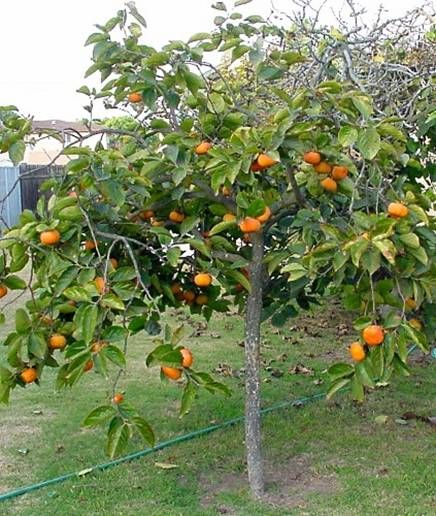
Identify the branches to remove: Determine which branches are crossing or rubbing against one another, as well as those growing inward or downward.
Make Clean Cuts: Using pruning shears or loppers, make clean cuts just outside the branch collar, avoiding leaving stubs.
Remove Suckers and Water Sprouts: Trim away any suckers or water sprouts that grow from the tree’s base or along its limbs.
Thin the canopy: remove overloaded branches to enhance air circulation and sunlight penetration in the canopy.
Step back and analyze: As you prune, take periodic breaks to analyze the overall shape and balance of the tree.
Debris Disposal: Collect and properly dispose of any clipped branches or debris.
Care and maintenance of persimmon trees in Florida
Persimmon trees require proper care and upkeep to remain healthy and productive. Regular watering, especially during dry seasons, is vital to keep the soil moist but not waterlogged. Mulching around the base of the tree helps to conserve moisture and inhibit weeds. To promote healthy growth and fruit production, fertilise the tree once a year in the spring with a balanced fertilizer. Prune the tree in late winter or early spring to remove dead or diseased branches, increase ventilation, and form the canopy. Keep an eye out for pest and disease indicators, and act quickly to address them.
Typical Pests and Diseases of Persimmon Trees in Florida
Persimmon trees are sensitive to various pests and diseases, which can harm their health and yield. Common pests include aphids, scale insects, and caterpillars, which can feed on leaves and fruit. Diseases such as fungal leaf spot, powdery mildew, and bacterial blight can also affect persimmon trees, causing leaf discoloration, fruit rot, and overall decline. Proper sanitation practices, including pruning infected branches and removing fallen leaves and fruit, can help prevent the spread of diseases. Additionally, applying fungicides or insecticides as needed can help control pest and disease outbreaks.
Related Posts:
Harvesting and Storage of Persimmon Fruit
Harvest persimmon fruit when it is fully ripe and has developed its characteristic color and soft texture. Depending on the variety, persimmons may be ready for harvest from late summer to fall. To harvest, gently twist the fruit from the tree or use pruning shears to cut the stem. Handle the fruit carefully to avoid bruising or damaging the delicate skin. Store ripe persimmons in the refrigerator for up to a few weeks, or freeze them for longer-term storage. You can also dry or process persimmons into various products like jams, jellies, and baked goods to extend their enjoyment.
Landscaping with Persimmon Trees in Florida
Persimmon tree landscaping can improve the aesthetics and functionality of your outdoor space. These trees have stunning foliage, with brilliant green leaves that turn yellow, orange, and red in the autumn, adding to the visual appeal of the environment. Furthermore, you can enjoy the wonderful fruit that persimmon trees yield, either raw or used in cooking and baking, adding a useful element to your garden. Consider the mature size and shape of persimmon trees while designing your landscaping, making sure they have enough space to thrive without crowding out other plants. Incorporating persimmon trees into your landscape can provide shade, solitude, and fresh produce for years to come.
FAQS
When is the ideal time to fertilize your persimmon tree?
Fertilise persimmon trees with a balanced fertilizer in early spring, before new growth begins. Don’t fertilise in late summer or autumn to prevent frost-harmed new growth.
Do persimmon trees need pruning?
Pruning persimmon trees helps to remove dead or diseased branches, increase air circulation, and shape the tree for better fruit output. Pruning should be done during the dormant season, which typically occurs in late winter or early spring.
How should I preserve my persimmon tree from pests and diseases?
Proper sanitation, regular inspections, and timely treatment of any pests or diseases are critical to the health of the persimmon trees. Furthermore, maintaining appropriate growing environments and avoiding stressors can aid in problem prevention.
How long does it take for a persimmon tree to produce fruit?
Persimmon trees normally give fruit 3–5 years after planting; however, this might vary based on the tree’s age, variety, and growing conditions.
Can you cultivate persimmon trees in containers?
A: You can plant some dwarf or semi-dwarf persimmon types in large containers, which makes them perfect for patio or balcony gardens. Make sure the container has appropriate drainage and care.
Conclusion
Finally, persimmon trees are not only attractive additions to landscapes, but they also produce delicious fruit and provide several benefits. These trees are native to Florida and flourish in a wide range of climates and soil conditions, making them flexible and versatile. Persimmon trees may thrive and produce abundant harvests for many years with proper care and maintenance, including regular watering, pruning, and pest management. Whether you’re an experienced gardener or a beginner, planting a persimmon tree may be a gratifying experience that provides both visual appeal and culinary enjoyment. So, add this magnificent tree to your landscape and enjoy the many benefits it has to offer.
How useful was this post?
Click on a star to rate it!
Average rating 0 / 5. Vote count: 0
No votes so far! Be the first to rate this post.

